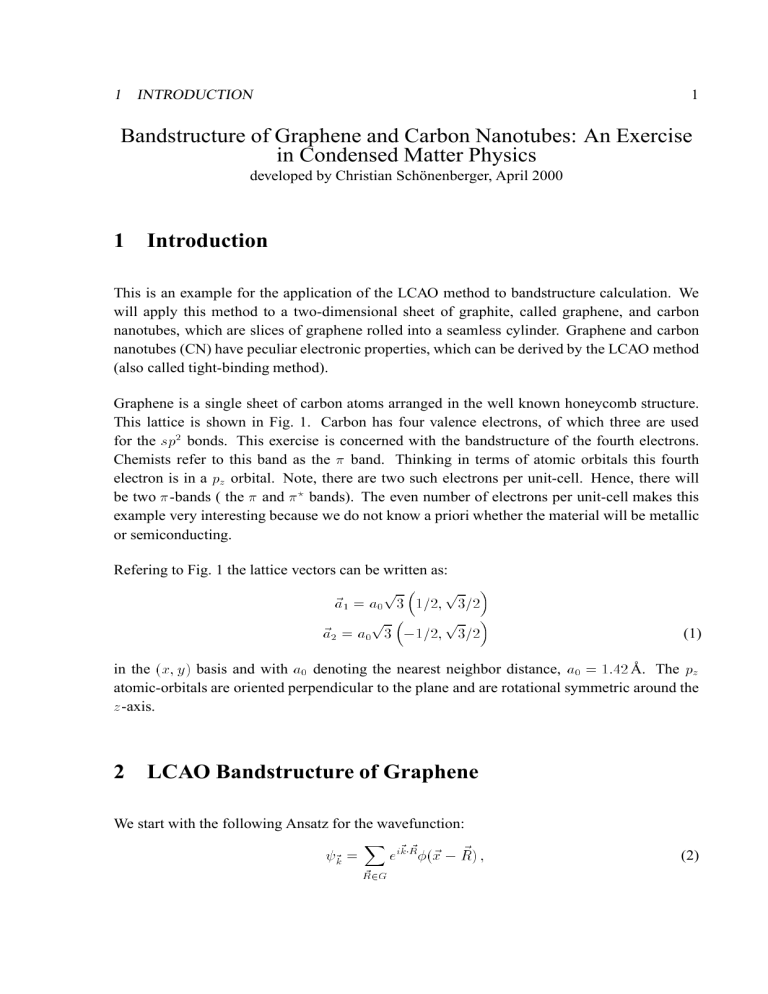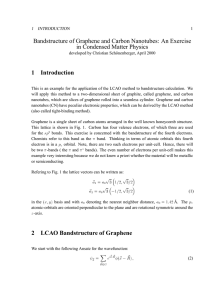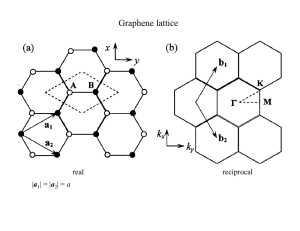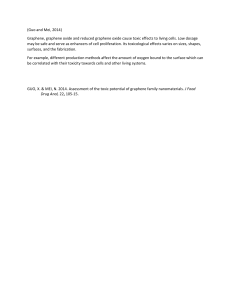
1 INTRODUCTION 1 Bandstructure of Graphene and Carbon Nanotubes: An Exercise in Condensed Matter Physics developed by Christian Schönenberger, April 2000 1 Introduction This is an example for the application of the LCAO method to bandstructure calculation. We will apply this method to a two-dimensional sheet of graphite, called graphene, and carbon nanotubes, which are slices of graphene rolled into a seamless cylinder. Graphene and carbon nanotubes (CN) have peculiar electronic properties, which can be derived by the LCAO method (also called tight-binding method). Graphene is a single sheet of carbon atoms arranged in the well known honeycomb structure. This lattice is shown in Fig. 1. Carbon has four valence electrons, of which three are used for the sp2 bonds. This exercise is concerned with the bandstructure of the fourth electrons. Chemists refer to this band as the band. Thinking in terms of atomic orbitals this fourth electron is in a pz orbital. Note, there are two such electrons per unit-cell. Hence, there will be two -bands ( the and ? bands). The even number of electrons per unit-cell makes this example very interesting because we do not know a priori whether the material will be metallic or semiconducting. Refering to Fig. 1 the lattice vectors can be written as: p p ~a = a 3 1=2; 3=2 p p ~a = a 3 ,1=2; 3=2 1 2 0 (1) 0 ( ) = 1 42 in the x; y basis and with a0 denoting the nearest neighbor distance, a0 : Å. The pz atomic-orbitals are oriented perpendicular to the plane and are rotational symmetric around the z-axis. 2 LCAO Bandstructure of Graphene We start with the following Ansatz for the wavefunction: ~k = X ~ 2G R ei~kR~ (~x , R~ ) ; (2) 2 LCAO BANDSTRUCTURE OF GRAPHENE 2 y 2 a0 a2 a1 1 x1 x ax | a(1,2) | = a = √3 a0 a1 = a0√3 (1/2,√3/2) a2 = a0√3 (-1/2,√3/2) Figure 1: Lattice of graphene. Carbon atoms are located at each crossings and the lines indicate the chemical bonds, which are derived from sp2 -orbitals. Also shown are the primitive lattice vectors ~a1;2 und the unit-cell (shaded). There are two carbon atoms per unit-cell, denoted by 1 and 2. where G denotes the set of lattice vectors. According to the construction, this is a Bloch wave. Such a representation is also called Wannier function. ~x are the atomic wavefunctions, i.e. the pz atomic orbitals. Now, we have to take into account that there are two such orbitals per unit-cells. We call these functions 1 and 2 , where the index refers to the resepctive carbon atoms. It is important to remember that the LCAO approximation assumes that the atomic wave-functions are well localized at the position of the atom. The total function is a linear combination of 1 and 2 : () (~x) = b (~x) + b (~x) = 1 1 2 2 X n bnn (3) Next, we consider the Hamiltonian for a single electron in the atomic potential given by all the carbon atoms: X H = 2~pm + Vat(~x , ~x , R~ ) + Vat(~x , ~x , R~ ) 2 ~ 2G R 1 2 (4) Recall that ~x1;2 denote the position of the two carbon atoms within the unit-cell. Applying for 2 LCAO BANDSTRUCTURE OF GRAPHENE 3 example 1 to this Hamiltonian results in: 0 1 X H = + @ Vat(~x , ~x , R~ ) + Vat(~x , ~x , R~ ) + Vat(~x , ~x )A 1 1 1 1 ~ 6=0 R 2 2 (5) 1 Here 1 is the eigenvalue for the atomic pz state. The second part to the right of this equation looks very ugly, so we abbreviate it by U11 . It is important to realize that this product is small, because U1 is small in the vicinity of atom and 1 is small everywhere away from location . With this abbreviation we have the following two equations, which are the starting point of the LCAO calculation: 1 1 H ; = ; + U ; ; 12 12 This can be further simplified by noting that energy. We choose 1;2 . Therefore: =0 H = U 1 1 12 = 1 and 1 2 (6) 12 and that we are free to set the zero of H = U 2 2 (7) 2 We need to solve the Schrödinger equation: H ~k = E (~k) (8) ~k Since there are two parameters, b1 and b2 , two equations are required for this eigenvalue problem. They are simply given by projecting on to the two states 1 and 2 . Show that: E (~k)hj j i = hj jUj j i (9) Calculate the terms h1 j i and h2 j i. Assume that only nearest-neighbor overlap integrals have to be taken into account. For example, ?1 2 is non-zero as is ?1 ~x 2 ~x , ~a1 , see Fig. 1 We obtain the two equations: R Z h j i = b + b 1 1 h j i = b + b 2 2 2 Z 1 R () ( ? 2 1 ? 2 1 + e,i~k~a1 + e,i~k~a2 1+e 1 i~k~a1 +e i~k~a2 ) (10) We will assume that the overlap integral is real: Z 0 = ? 2 1 2 R (11) 2 LCAO BANDSTRUCTURE OF GRAPHENE 4 In the next step we need to calculate hj j Uj j i. Again, only on-site and nearest-neighbor overlap integrals will be considered. Furthermore, you can use the abreviation: Z 1 Z = U = ?U ? 1 1 2 2 2 (12) 1 The two integrals are equal because interchanging the indicies should not matter due to symmetry and 1 2 R. We arrive at the following two equations: ,i~k~a ,i~k~a h jU j i = b 1 + e +e i~k~a i~k~a 1 1 h jU j i = b 2 1 2 1 1 1 1 1+e 1 2 +e 2 (13) Putting everything together, i.e. Eq. (9), (10) and (13), and using the abbreviation (~k ) = 1 + e,i~k~a + e,i~k~a 1 2 , (14) the eigenvalue problem is finally formulated as: ! ( E (~k) , ) b = 0 b 0 E (~k) E (~k) ? ( E (~ k) , ) 0 For 0 0 1 1 (15) 2 1 = 0 and = 0 the solution is simply E (~k) = 0, as it should be. The dispersion relation 1 E (~k) is obtained from Eq. 15 in the standard way by putting the determinant to zero. Try to express E (~k ). Make use of the fact that is small. If the latter is used, one obtains (as an 0 approximation) the very simple dispersion relation E (~k) = 1 (~k) (16) Calculate the magnitude of . One obtaines: E (~k) = q 1 3 + 2cos(~k ~a ) + 2cos(~k ~a ) + 2cos(~k (~a , ~a )) 1 2 This result is often expressed in a different form by using the Show that: 2 1 (x; y) components for ~k, see Fig. 1. v u p ! ak u 3 ak ak y x x t E (kx; ky ) = 1 + 4cos cos + 4 cos 2 2 2 2 1 p a is the lattice constant, i.e. a = 3a . 0 (17) (18) ~ -POINT 3 RECIPROCAL LATTICE OF GRAPHENE AND THE K 5 As an next exercise, plot this function using Maple or Mathematica. Discuss the bandstructure and try to answer the question whether graphene is a metal or a semiconductor. Recall, there are two valence electrons per unit-cell. Where is the Fermi energy? ) p2 Discuss the eigenspace at ~k . From Eq. 15 we obtain: b2 b1, so that 1 2 = with the plus sign valid for E > and the minus sign for E < . The symmetric combination (i.e. E > ) corresponds to the antibonding state and the the asymmetric combination to the bonding one. =0 0 = 0 =( 0 3 2 1 E/γ1 0 –1 –2 –3 –4 –2 K 0 2 4 4 2 0 a kx –4 –2 a ky Figure 2: LCAO-bandstructure of graphene. 3 Reciprocal Lattice of Graphene and the K~ -Point Draw the reciprocal lattice, the primitive vectors ~b1 and b~2 and the 1. Brillouin zone (BZ). The BZ is hexagonal. There are six corner points located at the BZ boundary. These points are called K -points. Show that j~b ; j = 34a 12 (19) 0 In Fig. 3 one K-point is shown with its respective wavevector K~ pointing along the x-axis. ~ -POINT 3 RECIPROCAL LATTICE OF GRAPHENE AND THE K 6 y a1 a2 b2 b1 x K resiprocal lattice points 1. Brillouin zone Figure 3: Reciprocal lattice of graphene with the 1st Brillouin zone (shaded). ~b1 and ~b2 are the primitive lattice vectors. Show that K~ = p4 ~ex 3 3a (20) E (K~ ) = 0 (21) 0 Use this result to prove that Once again the question, how large is EF ? The eigenvalue is zero for all K-points, but how large is the dimension of the Eigenraum? In order to answer this question, one has to have a look at Eq. 15. The answer is simple: The ‘Eigenraum’ is C2 , i.e. b1 and b2 can be choosen arbitrarily. It is common practice (also in view of the symmetry of the states at ~k ) to use normalized symmetric and antisymmetric pz ~x , ~x1;2 . The wavefunctions. If pz ~x is the atomic pz orbital, then we can write 1;2 ~x symmetric s and antisymmetric a wavefunctions are: =0 () ( )= ( s;a = p1 (pz (~x , ~x ) pz (~x , ~x )) 2 1 There are two degenerate wavefunctions at ~k ~ (s;a) K; (~x) = 2 ) (22) = K~ : X ~ 2G R eiK~ R~ s;a (~x , R~ ) ( ) (23) The symmetric wavefunction is called the ‘antibonding’ state and the antisymmetric one is the ~ these two states are degenerate. Therefore, this distinction is ‘bonding’ state. However, at K unimportant here. 4 CARBON NANOTUBES 4 7 Carbon Nanotubes The following figure, Fig. 4, shows the structure of carbon nanotubes. Fig. 4(a) is a so-called ‘armchair’ tube. This special type of nanotube is obtained from a slice of graphene cut along the x-axis and then rolled into a seamless cylinder in the y direction. Hence, the tube axis is in the x direction. Since nanotubes are seamless objects, the wavefunctions have to obey periodic boundary conditions around the circumference. (a) (b) (c) Figure 4: (a) shows a so-called armchair carbon nanotube, (b) a zig-zag tube, and (d) a general chiral tube. The next task is to obtain the one-dimensional bandstructure for an armchair nanotube (NT) using the two-dimensional bandstructure of graphene. The latter has to be sublemented by periodic boundary conditions. The armchair NT is obtained by cutting out a slice from the graphene sheet oriented parallel to the x-axis. The slice has a width, which can be expressed ~ oriented perpendicular to the tube axis. For an as the length of the so-called wrapping vector w armchair NT, the wrapping vector is of the form: w~ = N (~a + ~a ) 1 (24) 2 ( ) where N is an integer. Usually, this is also denoted as an N; N tube, because the wrapping vector is equal to N times ~a1 plus N times ~a2 . Due to the periodic boundary conditions along the y -direction, the wavevector component ky is quantized. Show that ky (m) = m 2p , m 2 Z N 3a (25) 4 CARBON NANOTUBES 8 The NT is one-dimensional. What is the lattice constant for an armchair NT? How many valence electrons belong to the one-dimensional ( d) unit-cell? The answer is N and not N as one might have expected! How long is the 1st Brillouin zone? Plot the d bandstructure for a ; tube, i.e. N using Maple (or Mathematica). Since N there are independent m values which are expected to give rise to bands with energies > and with < . However, because N graphene unit-cells are cast into one armchair unit-cell, there are such bands with E > and E < , each. The bands corresponding to index m and ,m are independent and degenerate, provided m 6 and m 6 N . This can best be seen by drawing the allowed ~k in reciprocal space, see Fig. 6. Again, I ask the question, is an armchair tube metallic or semiconducting? How large is the electric conductance of an ideal armchair nanotube with ideal contacts? 1 (10 10) = 10 =0 2 0 20 4 1 = 10 10 0 =0 2 =0 10 10 = E/γ1 1. BZ 20 "antibonding" bands 20 "bonding" bands −π/a π/a kx 3π/2a Figure 5: Bandstructure of a (10; 10) armchair carbon nanotube. The shaded region is the 1: Brillouin zone. Note, each band is doubly degenerate, except for the ones crossing maximal and minimal energy. There are in total 40 bands. E = 0 and the ones with If you still have fun, let us calculate the bandstructure of a so-called zig-zag tube. These tubes ~ N~a1 or vice versa w~ N~a2 denoted as N; or ; N have wrapping vectors of the form w tubes, respectively. Calculate the d bandstructure of a ; tube and of ; tube. What is the main difference? 1 = = (9 0) ( 0) (0 ) (10 0) ~ 5 EXPANSION AROUND K 9 ky K K ky = 2π m ( ) √3a N 2π √3a K 4π/3a kx π/a Figure 6: Shown is the 1: Brillouin zone in reciprocal space. The lines are the allowed (and independent) ~k giving rise to the 1d-bandstructure of a (10; 10) armchair carbon nanotube. 5 Expansion around K~ Since the Fermi-energy is located at the K-points, the low energy properties can be well de~ . We will first look at the energy eigenvalue scribed by expanding the wavefunctions around K K~ ~ and E ~k E K~ ~ ~ . Now exproblem, i.e. Eq. 15. We write: ~k ~ . Then, instead of Eq. 15 one obtains the new press the function ~k as a linear expansion at K eigenvalue equation: = () 3 (~) 1 a0 (x , iy ) 2 ( ) = ( )+ ( ) = ( ) + 3 1 a0 2 (x + iy ) b = 0 (~) b 0 1 (26) 2 The dispersion relation is obtained by setting the determinant to zero: 3 a (~) = 2 j~j 1 0 (27) Hence, we find a very simple relation. The velocity of a wavepaket is given by ~v It is idenpendent of direction and in magnitude given by: vF = 3 2ha 1 = 1 42 = h , @=@~. 1 0 =29 The parameters are known: a0 : Å, 1 : eV, and consequently vF the velocity vF we can write Eq. 27 in a much nicer form: (~) = h vF j~j (28) 10 6 m/s. Using (29) ~ 5 EXPANSION AROUND K 10 It is interesting to have a look at the structure of the eigenvectors can be written as: 1 (b ; b ) = p12 ,ei = ; e,i = 1 = (b ; b ). Show that this vector ( + ) 2 2 2 2 (30) () + where arg x iy . arg denotes the angle of the complex vector x iy . Recall that b1;2 describe the amplitude of the pz orbitals for the two carbon atoms in the unit-cell. In the following we would like to study matrix element of the form h~1 j~2 i. Such matrix elements contain an overlap integral. If b(1;2) are chosen according to Eq. 30, then, one obtains for example jhjij = 1 + cos( ) 2 1 (31) 0 Since 0 , the second part can be neglected. Neglecting the orbital part, we can represent b1; b2 , the wavefunction as a two-component vector with components b1 and b2, i.e. where refers to the two possibilities. The sign correpsonds to states with E > and the , sign to those with E < . Prove the following set of relations: + 0 0 =( jh~ jh~ ij = 1 jh~, jh~, ij = 1 jh~ jh,,~ ij = 1 h~ jh,~ i = 0 h~, jh,,~ i = 0 + + ) 2 2 + 2 + + (32) One can also obtain the angle dependence easily: h~p j~q i = pqcos ( =2) + (1 , pq)sin ( =2) , (33) where (p; q ) 2 and = , . These selection-rules are important for transport in 2 1 2 2 2 2 1 graphene and carbon nanotubes. For the latter, the former set of equations, Eq. 32, is particularly interesting. The result is schematically drawn in Fig. 7. The only allowed scattering processes is ; $ ,; , . Though an interband transition, the direction of motion (and the velocity) is retained in this scattering process. Hence, this scattering does not introduce an electric resistance. Carbon nanotubes are therefore expected to have large mean-free paths and very low electric resistances, which is indeed observed. (+ ) ( ) ( ) There is a very interesting relation with spin physics. In fact, the two-component vector b1 ; b2 can be considered a pseudo-spin in the spin-basis, in which z (Pauli matrix) is diagonal. That p is, ; is the up-spin eigenstate and ; the down-spin. The combinations ; = are then eigenstates of x with eigenvalues . These two pseudo-spins belong to states which propagate along the x-axis (see Eq. 30 for ). Let us denote these two states as: (1 0) (0 1) 1 j "ix ( 1 1) 2 =0 and j #ix . (34) ~ 5 EXPANSION AROUND K 11 h = -1 h=1 + =0 κ =0 allowed - Figure 7: Selection rules for intra- and interband transitions in carbon nanotubes close to K . h denotes the ‘helicity’ of the pseudo-spin (see text). + refers to the upper band (E (E < 0). > 0) and , to the lower The pseudo-spin for a state with arbitrary wavevector ~ is obtained by rotation about the z -axis with angle . This rotation is described by Uz ( ) = ei = 0 2 0 e,i = (35) 2 Applying this to the states j "ix , j #ix indeed gives the result of Eq. 30. ~ ? The total wavefunction How do the wavefunctions look like in the vicinity of K product of K~ , ~ and the slow-varying function exp i~ ~x : ( ) x) = K~ (~x)~ ei~~x; with ~k = K~ + ~ ~k (~ This function is an approximation valid close to obeys the Bloch equation ~k K~ . is the (36) It is a Bloch wavefunction and therefore (~x + R~ ) = ei~kR~ ~k (~x) (37) Using the pseudo-spin we may also write the wavefunction as: ~k (~x) = K~ (~x) Uz ( ) eix xj " or #i (38) The pseudo-spin is tight to the direction ~, such that the spin is either parallel or antiparallel to ~. Hence, these ‘particle’ have a well defined helicity. This is like ‘neutrino’ physics! The 6 NANOTUBE WITH A GENERAL WRAPPING VECTOR 12 similarity goes even further, since the sign of the helicity is defined by the sign of the energy. For each ‘particle’ with E > there is an ‘antiparticle’ with E < , but with reversed helicity. Unlike the neutrino, the ‘particle’ has positive helicity here! For further reading, see Paul McEuen et al. Phys. Rev. Lett. 83, p5098 (1999). 0 6 0 Nanotube with a general wrapping vector We will use the result of the previous section to derive the approximate bandstructure for carbon ~ is assumed nanotubes (NTs) valid in the vicinity of the Fermi energy. The wrapping vector w to be w~ = n~a + m~a ; 1 (39) 2 ( ) with n and m integers. This tube is denoted as an n; m tube. Decompose the wavevector ~ into a component along the tube axis (kk ) and one perpendicular to it (k? ). Accordingly: ~ = kk~ek + k?~e? with ~e? = w~ =jw~ j (40) Because of the periodic boundary condition around the tube circumference (i.e. direction w ~ ), the transverse wavevector k? will be quantized. Use Eq. 37 to show that the allowed k? are given by: k?;p = 2 (m , nd)=3 + p where d = jw~ j (41) Here p 2 Z and d denotes the tube diameter. Next, use this result and the dispersion relation Eq. 29 to find the final result for the (approximate) one-dimensional bandstructure of carbon NTs: s kkd m , n 2 h v F p(kk) = d 3 +p + 2 2 2 (42) Discuss this bandstructure. When is a NT metallic and when is it semiconducting? How large is the bandgap? Draw the dispersion relations. The result is shown in Fig. 8. 1 If you are not exhausted yet, you may try to calculate the d-bandstructure for an arbitrary tube, i.e. a N; M -tube. Such a tube has the wrapping vector w ~ N~a1 M~a2. Now, one first need to calculate the unit vector ~ek directed along the tube axis. Furthermore, we need to know the ( ) = + 7 CLOSING REMARKS 13 E/E0 2 1 k n1d k n1d -1 (a) -2 E/E0 2 1 -1 (b) -2 Figure 8: Approximate one-dimensional bandstructure of carbon nanotubes (left) and corresponding density-of-states (right). There are two kind of nanotubes: metallic and semiconducting one. A tube is metallic, if (m , n) 2 3Z. The bandgap Eg of a semiconducting tube is inversely proportional to the diameter and equal to Eg = 2E0=3, where E0 = 2 hvF =d. 1d lattice constant, i.e. the length of one unit-cell of the 1d nanotube. This can be described by the unit-cell vector ~a d / ~ek : M + N )~a , (2N + M )~a , ~a d = (2GCD (43) (2M + N; 2N + M ) where GCD() denotes the greatest common divisor. 1 1 7 1 2 Closing remarks If you have completed the whole programme yourself you can be very proud! You should now understand Bloch’s theorem, the consequences of periodic boundary conditions, when a material is a metal or a semiconductor. Moreover, you have participated in a problem which is currently of great interest in research. 8 APPENDIX 8 14 Appendix E/γ1 (9,0) E/γ1 Eg 0 E/γ1 (10,0) (11,0) E/γ1 (12,0) Eg Figure 9: One-dimensional bandstructures of different zig-zag tubes. Only the ‘upper’ part for E >0 is shown. The occurence of bands with no dispersion at all (infinite mass !) may appear surprising. But looking again at the surface of the d bandstructure of graphene, one can indeed see directions for which E const, see Fig. 10. = 2 8 APPENDIX 15 2 0 –8 –6 –4 –2 –2 –10 –8 –6 –4 –2 0 0 2 4 2 6 8 10 4 Figure 10: Again a plot of the banstructure of graphene. Indicated are special lines in ~k -space for which the energy is constant.





